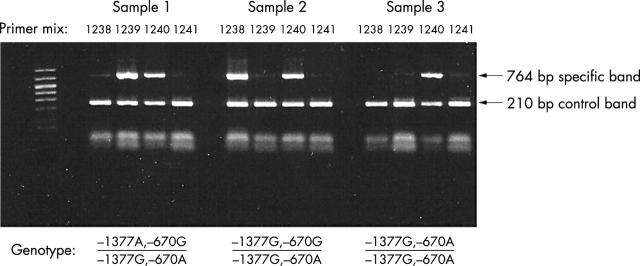Abstract
Objective: To examine genetic variation in the promoter region of the Fas gene in pSS.
Methods: Two single nucleotide polymorphisms at positions -1377(G/A) and -670(G/A) in the Fas gene promoter were genotyped by PCRSSP in 101 patients with pSS and 108 Caucasoid controls.
Results: No significant differences in allele or genotype frequencies were detected between the patients with pSS and controls. However, significant associations were observed with Ro/La autoantibody negative patients, who display milder and later onset disease. The -670A allele was more frequent in Ro/La autoantibody negative patients than in Ro/La autoantibody positive patients (p = 0.04).
Conclusion: This study does not confirm an earlier report of an association between pSS and the Fas promoter -670G allele. However, the results suggest that genetically determined variability in Fas expression may modulate Ro/La autoantibody responses in patients with pSS.
Full Text
The Full Text of this article is available as a PDF (269.9 KB).
Figure 1 .
Fas promoter genotyping by haplotype specific polymerase chain reaction (PCR). Four haplotype specific PCR reactions (table 1) were used to amplify cis combinations of the Fas promoter -1377 and -670 polymorphisms. Genomic DNA was amplified in 13 µl reaction mixtures consisting of 67 mM Tris base pH 8.8; 16.6 mM ammonium sulphate; 2 mM magnesium chloride; 0.01% vol/vol Tween 20; 200 mM of each of dATP, dTTP, dGTP, and dCTP; 0.1–0.01 µg DNA; 3.4 mM haplotype-specific primers, 6.8 mM control primers; and 0.1875 units of Taq polymerase. Thermal cycling parameters were: 1 minute at 96°C; 5 cycles of 96°C for 25 seconds, 70°C for 45 seconds and 72°C for 45 seconds, followed by 21 cycles of 96°C for 25 seconds, 65°C for 50 seconds and 72°C for 45 seconds; followed by 4 cycles of 96°C for 25 seconds, 55°C for 60 seconds and 72°C for 120 seconds. PCR products were electrophoresed in 1.0% agarose gels containing 0.5 mg/ml ethidium bromide and visualised under ultraviolet illumination. Direction of electrophoresis is upward.



